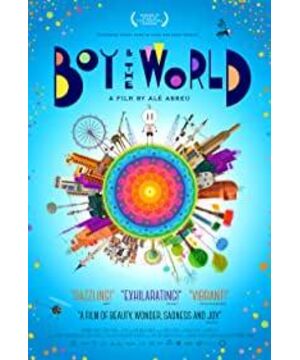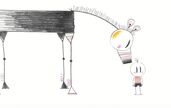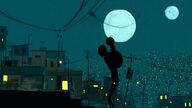The animation film with the best reviews this year turned out to be a very simple "Boy and the World" from Brazil, which won the first prize at the Annecy Animation Film Festival in France. How simple is it? The protagonist boy’s limbs are four lines, his hands are like chicken feet, his legs and feet are like golf clubs. On the poster, in the center of the rail, his big round head with three hairs has a pair of eyes erected, which looks like the video is pressed. When the pause button is pressed, even the clothes, flowers and birds are colored, but they are not full of crayons. If you are accustomed to the kind of big Hollywood animations with singing and dancing and rich colors, or those Japanese and French animations that admire the picturesque style, you may not be able to bear this style of painting, but if you bear it, you will see an unbelievable return to reality. The world is not just the world of Brazil, but the world of the whole world. Such a simple style of painting is related to the ideology and theme. At the beginning of the animation, a little boy is playing in his own wilderness. Against a pure white background, the boy is curious about a colorful stone on the ground that is turned into a kaleidoscope. It emits a constant flute melody. Then his attention is attracted by butterflies, and then a bucket. Daniel, the forest, the content of the picture is getting richer and richer, he came to the whole colorful world, and jumped onto the white cotton-like clouds in the blue sky...until this complete freedom was interrupted by the train chimneys in the distance. In the same sequence as the previous picture, the child returned to the colored stones, but this time there was a call from the mother, and they had to face their father’s journey on the caterpillar train alone... this prologue is not only a whole The mini preview of this animation is also the life preview of "Simplified-Traditional-Simplified". Dad left home to work. The boy’s original world collapsed. He kept seeing the figure of his imaginary father and the things they had done in his hometown. Among them was a foreshadowing: Dad loves to play the flute, and he always plays the title colored stones. In the familiar monotonous melody, the boy put the notes in the air and his mother’s singing into a small pot and buried it in the ground; father and mother also planted a tree together. The child trapped in the countryside without a father is doomed to rebellion. He finally left home on a rainy night, and he learned to take a suitcase with exaggerated size and weight and family portrait photos, and board the train...Director (also screenwriter) Alê Abreu did not explain how the child met the old cotton field farmer, but suddenly changed the style of painting, showing the nightmarish bumps along the way with a series of fast-changing black line drawings. When he woke up, the boy joined the old man and other farmers to pick cotton uniformly. At work, this part of the picture seems to be beautiful and harmonious, as if showing an ideal working environment, but the atmosphere is quickly swept away by the unknown atmosphere brought by giant trucks and airplanes, and the old man with a cough is instantly driven by the farmer-you would guess, Is coughing bronchitis caused by cotton fiber? It was another rainy night, and children, old people and dogs were caught in the waves of the big river—you would guess again, does this allude to the Amazon River in Brazil? But the director laughed and didn't answer, and then suddenly put them under a big red tree in an elegant manner—you have to guess again, is this the national etymology of Brazil, Brazilian mahogany? The child climbed up the tree and saw the man in the car who looked like his father. The director continued to silently send the boy directly to the cloth factory, the destination of cotton, and continued to show the hustle and bustle of the city, the arrogance of the military government, the lonely life of the workers, the mechanized mass production forcing workers to lose their jobs, and the export of cloth to foreign countries. I made ready-made clothes and sold them back to my country at a high price. The war was chaotic, the resources were overexploited, and the trees were severely felled... The real felling video suddenly cut in, which produced a strong visual impact. The pyramid-like urban design also confirms that Brazil’s most developed and most densely populated cities are located in the southeast area of the Atlantic coast, where there are Sao Paulo and Rio, and the south is also the plateau area. The environment deteriorated to the end, every stranger turned into a father, and the boy who was looking for his father hopelessly had to look back on his childhood memories like heaven. At this point, the director started quietly unveiling: the old, the young, and the children are actually the same person. What the film says is the fable about the development of Brazil, the fable of the global economy, the fable that the agricultural culture is destroyed by the industrial culture, and the common story of the whole life of working people all over the world. This is the general magical reality of "A Hundred Years of Solitude", and it is also a moment of parallel Proust time. The story has long foreshadowed: the clothes of children, the elderly, and the youth are the same color; the tree planted by the parents grows into a small sapling when the boy is young, and becomes the big red tree in his later years; the young worker who has just become unemployed wears his mother weaving Colored hats, reading the cotton field recruitment poster... What’s interesting is that no matter what age, whether in the cotton field or the cloth factory, boys have never lost their innocence. The beauty represented by playing music is the confrontation between boys. The malicious weapon of the world is also a magic weapon for him to coexist peacefully with the world. The musical notes are colored, and the brocade clothes worn by young artists are also colored. The birds of happiness that rise from people’s songs are also colored. The birds of happiness are related to industry and war. , The black giant bird struggle turned into by the convergent culture, even if it falls, it can still be resurrected like Lazarus. The director’s childlike imagination has turned into many elegant scenes, such as rainy days turning into waves on the river, such as the boy looking at the kaleidoscope in his hand wholeheartedly, stepping on the big boat from the "springboard" inadvertently, crossing the ocean, and stringing cloths. The whole process of ready-to-wear. "Golden Week of Bean" once used this method to show how the off-line Mr. Bean walked out of the room, stepped on the roofs of different sizes, and finally reached Cannes Beach in a straight line. It not only humorously shows the character of Bean, but also satirizes the traffic. Clogged modern street scenes, and "Boys and the World" uses the same method to a deeper connotation because of the congenital conditions that animation can be unconstrained. The elegant story is not over yet, the lonely old man, wearing the colorful hat and clothes of his youth, finally returned to the colored stone at the beginning of the film. It turned out that it was the can he had buried and opened it. He could still hear the familiar notes he treasured: father's flute, mother's singing. He can return to his parents' arms and rejuvenate. This article was published on "The Paper" on December 3, and was slightly deleted when it was published. The director’s childlike imagination has turned into many elegant scenes, such as rainy days turning into waves on the river, such as the boy looking at the kaleidoscope in his hand wholeheartedly, stepping on the big boat from the "springboard" inadvertently, crossing the ocean, and stringing cloths. The whole process of ready-to-wear. "Golden Week of Bean" once used this method to show how the off-line Mr. Bean walked out of the room, stepped on the roofs of different sizes, and finally reached Cannes Beach in a straight line. It not only humorously shows the character of Bean, but also satirizes the traffic. Clogged modern street scenes, and "Boys and the World" uses the same method to a deeper connotation because of the congenital conditions that animation can be unconstrained. The elegant story is not over yet, the lonely old man, wearing the colorful hat and clothes of his youth, finally returned to the colored stone at the beginning of the film. It turned out that it was the can he had buried and opened it. He could still hear the familiar notes he treasured: father's flute, mother's singing. He can return to his parents' arms and rejuvenate. This article was published on "The Paper" on December 3, and was slightly deleted when it was published. The director’s childlike imagination has turned into many elegant scenes, such as rainy days turning into waves on the river, such as the boy looking at the kaleidoscope in his hand wholeheartedly, stepping on the big boat from the "springboard" inadvertently, crossing the ocean, and stringing cloths. The whole process of ready-to-wear. "Golden Week of Bean" once used this method to show how the off-line Mr. Bean walked out of the room, stepped on the roofs of different sizes, and finally reached Cannes Beach in a straight line. It not only humorously shows the character of Bean, but also satirizes the traffic. Clogged modern street scenes, and "Boys and the World" uses the same method to a deeper connotation because of the congenital conditions that animation can be unconstrained. The elegant story is not over yet, the lonely old man, wearing the colorful hat and clothes of his youth, finally returned to the colored stone at the beginning of the film. It turned out that it was the can he had buried and opened it. He could still hear the familiar notes he treasured: father's flute, mother's singing. He can return to his parents' arms and rejuvenate. This article was published on "The Paper" on December 3, and was slightly deleted when it was published.
-------------------------------------------------- -------
Please pay attention to my public account "Treehouse Fishing for the Moon".
View more about The Boy and the World reviews







